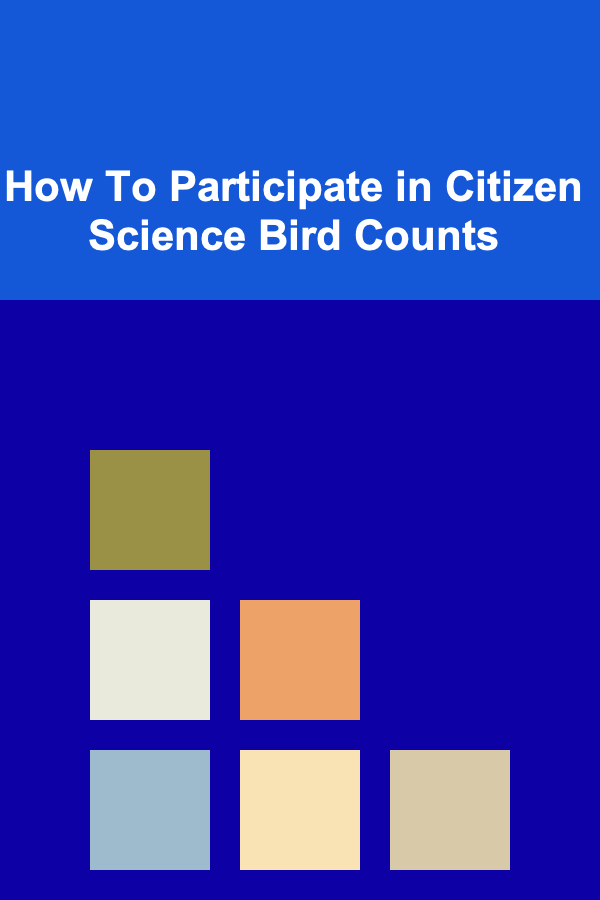
How To Participate in Citizen Science Bird Counts
ebook include PDF & Audio bundle (Micro Guide)
$12.99$7.99
Limited Time Offer! Order within the next:

Citizen science is an essential part of modern-day environmental research. It allows people from all walks of life to contribute to scientific research, providing valuable data that would otherwise be impossible to collect. One of the most accessible and impactful ways individuals can get involved in citizen science is through bird counting programs. These bird counts help scientists monitor bird populations, track migration patterns, and understand the health of bird species across the globe. If you're passionate about birds or nature in general, participating in citizen science bird counts is an enjoyable and meaningful way to make a difference.
In this article, we will explore what citizen science bird counts are, why they matter, and how you can get involved. We will cover everything from understanding the basics of bird counting, choosing the right bird count project, and the best practices to follow, to how your participation can help scientists with critical data on bird populations.
What Is Citizen Science?
Citizen science is a collaborative effort in which non-professional scientists (or volunteers) contribute to scientific research and data collection. By utilizing the power of community involvement, citizen science projects can cover vast geographic areas and collect large amounts of data, which would be difficult for scientists to obtain alone.
The concept of citizen science is not new. It has been in practice for centuries, but it has gained significant traction in the digital age due to advancements in technology and the ability to access and share data easily. Many citizen science projects focus on environmental issues, such as monitoring wildlife, tracking climate change, or recording weather patterns. One of the most popular and impactful forms of citizen science is bird watching and bird counting.
What Are Bird Counts?
Bird counts are a form of citizen science in which volunteers count and report the number of birds they observe in a specified area over a certain period of time. These counts can be done on a local, regional, or even global scale and play a crucial role in monitoring the health of bird populations. Bird counts allow researchers to track species distribution, migration patterns, and the impacts of environmental changes on bird populations.
Bird counts typically involve identifying bird species, counting the number of individuals in each species, and reporting the data to a central database or organization. This information is then used by scientists to analyze trends in bird populations and inform conservation efforts.
Some bird count projects focus on specific species or regions, while others encourage participants to count all the birds they see. These projects can range from large-scale, long-term studies to one-time events. Some bird counts are done in the field, while others can be done from the comfort of your home, such as through feeder watching or backyard bird surveys.
Why Are Bird Counts Important?
Bird counts play a critical role in environmental science. Birds are often considered indicators of ecosystem health. Changes in bird populations can reflect larger environmental issues, such as habitat loss, climate change, and pollution. By monitoring bird populations over time, scientists can gain insights into how ecosystems are changing and which species are most at risk.
Some of the specific benefits of bird counts include:
A. Tracking Species Population Trends
By regularly counting birds in specific areas, scientists can identify trends in bird populations. This helps them determine if certain species are declining or increasing in number. If a species is declining, it could be a sign that its habitat is being damaged or that it is facing other challenges, such as climate change or predation. Conversely, an increase in population might indicate successful conservation efforts or favorable environmental conditions.
B. Understanding Migration Patterns
Bird migration is a fascinating and complex phenomenon that has been studied for centuries. Bird counts provide essential data on migration patterns, helping scientists understand where birds are traveling, when they are migrating, and how long it takes them to reach their destinations. This information can also be used to track changes in migratory routes and identify areas where birds may need protection.
C. Assessing Habitat Health
Bird counts can help scientists assess the health of different habitats. For example, a significant decline in bird numbers in a particular area may indicate that the habitat is deteriorating or that food sources are becoming scarce. On the other hand, a rise in bird numbers in a newly protected area may show that conservation efforts are paying off.
D. Contributing to Conservation Efforts
Data from citizen science bird counts is often used by conservation organizations, researchers, and government agencies to shape policy decisions and conservation strategies. Your participation in a bird count can directly contribute to protecting endangered species, preserving habitats, and promoting biodiversity.
Popular Bird Count Programs
There are numerous bird count programs you can participate in, depending on where you live and your interests. Here are some of the most well-known and widely recognized bird count programs around the world:
A. The Audubon Society's Christmas Bird Count (CBC)
One of the oldest and most well-known citizen science bird counts in the United States is the Christmas Bird Count (CBC), which takes place annually from mid-December to early January. Established in 1900, the CBC invites volunteers to count birds in a designated 15-mile diameter circle. The data collected helps researchers track long-term population trends and assess the health of bird species.
B. The Great Backyard Bird Count (GBBC)
The Great Backyard Bird Count is a global citizen science project that takes place every year in February. It encourages participants to count birds in their backyards, parks, or other local areas for a minimum of 15 minutes. The results are submitted to a central database, where they contribute to a global understanding of bird populations and migration trends. The GBBC is one of the largest citizen science projects in the world, with participants from all over the globe.
C. The eBird Project
eBird is a global citizen science project managed by the Cornell Lab of Ornithology. It allows bird watchers to submit their bird sightings via a smartphone app or online platform. eBird collects data on bird populations, migration patterns, and species distribution from around the world. Participants can create personal birdwatching logs, track their sightings, and contribute to a global bird database.
D. The Breeding Bird Survey (BBS)
The Breeding Bird Survey is a North American program that focuses on monitoring bird populations during the breeding season. It is a long-term project that tracks trends in bird species that breed in specific regions. The survey requires participants to visit designated survey routes and count birds along the way. The data collected is used to assess the status of breeding bird populations and inform conservation efforts.
E. The Global Big Day
The Global Big Day is a 24-hour birding event that takes place each year in May. Birdwatchers around the world are encouraged to participate by counting as many species of birds as possible within 24 hours. The event is a fun and competitive way to engage with other bird enthusiasts and contribute to global bird data collection. All observations are submitted to the eBird database.
How to Participate in Bird Counts
Participating in citizen science bird counts is easy and can be done by almost anyone, regardless of experience level. Whether you're an experienced birdwatcher or a beginner, there are several steps you can follow to get involved:
A. Choose a Bird Count Program
First, decide which bird count program you'd like to participate in. If you're new to birdwatching, consider starting with a program like the Great Backyard Bird Count, as it requires minimal effort and can be done in your own backyard. For more experienced birders, programs like the Christmas Bird Count or the Breeding Bird Survey may be more challenging and rewarding.
B. Sign Up or Register
Many bird count programs require participants to register or sign up in advance. This helps organizers track participants and ensure the data collected is accurate. Some programs, like eBird, allow you to submit sightings directly through their app or website, while others may require you to report your results via email or paper forms.
C. Learn Basic Bird Identification
Before you start counting, it's helpful to learn how to identify the birds in your area. You don't need to be an expert birder, but knowing the basic characteristics of common species will help you identify them more easily. There are many online resources and apps, such as the Merlin Bird ID app, that can assist with bird identification.
D. Set Up a Counting Area
For backyard bird counts, set up a designated area where you can observe birds. This could be a window overlooking your garden, a spot in a local park, or even a bird feeder. Make sure you have a good vantage point to spot birds without disturbing them.
E. Start Counting
Once you're ready, start counting! Record the number of birds you see, the species you identify, and the time you spend observing. Some bird count programs may have specific guidelines on how to report data, so make sure to follow those instructions.
F. Submit Your Data
After you've completed your bird count, submit your observations to the appropriate program. This may involve entering your data into an online portal, sending an email, or filling out a paper form.
G. Share Your Experience
If you're enjoying birdwatching and want to share your experience, consider joining local birdwatching groups or online communities. This will allow you to connect with other bird enthusiasts, learn new tips and tricks, and stay up to date on future bird counting opportunities.
Best Practices for Bird Counting
While participating in a bird count is relatively straightforward, there are a few best practices you should follow to ensure accurate and helpful data collection:
A. Be Accurate in Your Counts
Take your time to observe and count accurately. It's essential to avoid over-counting or under-counting birds. If you're unsure about a species, it's better to skip it than to make an incorrect identification.
B. Count for the Entire Duration
If a program asks you to count birds for a specific period (e.g., 15 minutes), make sure you stick to that time frame. Consistency is key to ensuring the data you submit is useful.
C. Report All Observations
Whether you're counting 50 birds or just one, it's important to report all of your observations. Every bird counts, and even rare or unusual sightings can provide valuable data.
D. Stay Safe and Respectful of Nature
Remember to always respect wildlife and their habitats. Avoid getting too close to birds, and never disturb their natural behaviors. Make sure to follow any local laws and guidelines when participating in bird counts.
The Impact of Your Participation
By participating in citizen science bird counts, you're helping scientists gather essential data that can have a lasting impact on bird conservation and environmental research. Your efforts, along with the efforts of countless other volunteers, contribute to a global understanding of bird populations and the health of ecosystems.
As a participant, you'll not only be contributing to science but also gaining a deeper appreciation for the natural world. Whether you're observing birds in your backyard or traveling to a local wildlife reserve, bird counting connects you with nature in a meaningful way.
Conclusion
Bird counts are a fun, rewarding, and impactful way to participate in citizen science and contribute to environmental conservation. Whether you're a seasoned birder or just starting out, there are countless opportunities to get involved in bird counting programs and make a difference. By tracking bird populations and migration patterns, you help scientists monitor the health of our planet's ecosystems and ensure a brighter future for birds and other wildlife.
So, what are you waiting for? Grab your binoculars, register for a bird count, and start contributing to the protection of the world's bird species today.
Reading More From Our Other Websites
- [Star Gazing Tip 101] How to Record Accurate Timing Data for Variable Star Brightness Changes Using a DSLR
- [Organization Tip 101] DIY Stair Tread Replacement: A Beginner's Guide
- [Biking 101] Bike Hydration 101: Best Practices for Staying Cool and Fueled
- [Metal Stamping Tip 101] Material Matters: Selecting the Right Alloys and Sheet Thickness to Minimize Stamping Spend
- [Scrapbooking Tip 101] Best Ways to Integrate QR Codes Linking to Video Memories Within Pages
- [Screen Printing Tip 101] Budget‑Friendly Tips to Set Up a Home Screen‑Printing Studio
- [Home Soundproofing 101] How to Soundproof Your Windows for a Peaceful Home Environment
- [Home Party Planning 101] How to Plan the Ultimate Movie Night Party at Home
- [Organization Tip 101] How to Use Pet Gates to Define Spaces Effectively
- [Organization Tip 101] When to Use a Jigsaw vs. a Circular Saw for Home Renovations

How to Use Social Trading Platforms
Read More
How To Understand Unspoken Cultural Rules
Read More
How To Learn About Quantum Dot Quantum Computers
Read More
How to Build Resilience in Your Professional Life
Read More
10 Tips for Journaling to Unlock Your Creativity
Read More10 Common Mistakes to Avoid When Tracking Interview Costs
Read MoreOther Products

How to Use Social Trading Platforms
Read More
How To Understand Unspoken Cultural Rules
Read More
How To Learn About Quantum Dot Quantum Computers
Read More
How to Build Resilience in Your Professional Life
Read More